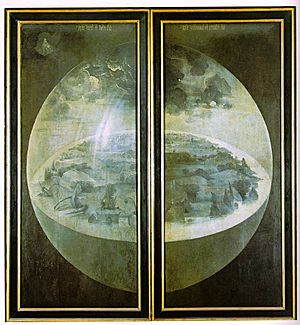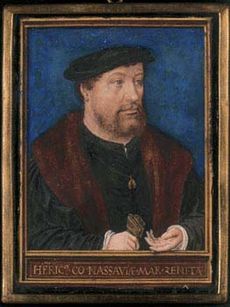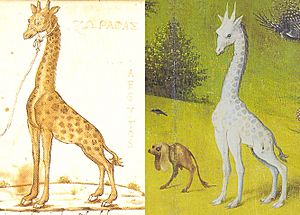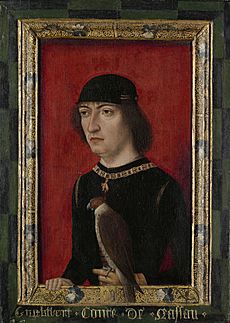The Garden of Earthly Delights facts for kids
The Garden of Earthly Delights is a famous large painting made by the Dutch artist Hieronymus Bosch. He painted it between 1490 and 1510, when he was in his middle ages. This artwork is a triptych, which means it has three panels painted with oil paint on oak wood. Today, you can see it at the Museo del Prado in Madrid, Spain.
Bosch created three big triptychs, and this one is special because you can "read" it from left to right. Each part helps tell the whole story. These paintings often showed themes about history and faith. Usually, triptychs from this time showed the Garden of Eden on the left, the Last Judgment on the right, and the main story in the middle. It's thought that The Garden was made for a wealthy person's home, not for a church, because of its very unique scenes.
Contents
What the Painting Shows
The Outside (When Closed)

When the painting is closed, you see the outer panels. These parts are painted in shades of green and gray, a style called grisaille. This lack of color might show a time before the sun and moon were created. It also made the colorful inside of the painting seem even more amazing when opened.
The outer panels are believed to show the creation of the world. You can see a new Earth covered only in plants. A tiny figure of God is in the top left corner. He wears a crown like a pope's hat, which was common in paintings back then. God is shown creating the Earth simply by speaking. A quote from the Bible, "For he spoke and it was done; he commanded, and it stood fast," is written above him. The Earth hangs in a dark space, with only God nearby.
Even though there are plants, there are no humans or animals yet. This means the scene shows the third day of creation from the Bible. Bosch painted the plants in a strange way, using gray colors that make them look like both plants and rocks. The sea surrounds the Earth, with light shining through clouds. These outer panels set the stage for the story inside. They show an empty Earth with only rocks and plants.
The Inside (When Open)
Experts believe Bosch used the outer panels to create a Bible-like setting for the inside scenes. The inside pictures are thought to be set later in time. Like Bosch's other works, the middle part is surrounded by images of heaven and hell. The scenes inside are believed to go in order: from left to right, they show the Garden of Eden, then the garden of earthly delights, and finally Hell. God appears on the left as the creator of people. The right panel shows what happens when people don't follow God's will.
When and Where the Painting Was

It's not exactly clear when The Garden of Earthly Delights was painted. Some experts thought it was an early work by Bosch. Others believed it was painted later, around 1503–1504. Scientists used tree-ring dating on the oak panels. This showed the wood came from trees cut between 1460 and 1466. Wood was usually stored for several years before being used for paintings.
Some clues inside the painting, like a pineapple, suggest it was painted after Christopher Columbus's trips to the Americas (1492–1504). However, the tree-ring dating has made some experts think it might be an earlier work. They also point out that there might be African objects in the painting instead of "New World" ones.
The first time The Garden was written about was in 1517, a year after Bosch died. A priest from Italy, Antonio de Beatis, saw it in the palace of the House of Nassau in Brussels. This palace was a very important place, visited by kings and queens. Because the painting was in such a famous location, some believe it was specially ordered, not just something Bosch painted from his imagination. In 1605, the painting was called the "strawberry painting" because of the many strawberry-like fruits in the middle panel.
Wealthy people in the Burgundian Netherlands, who were interested in new ideas from the humanist movement, were likely the ones who bought Bosch's paintings. We don't have many records of where his works were right after he died. It's likely that Engelbert II of Nassau, who died in 1504, or his nephew Henry III of Nassau-Breda, ordered the painting. De Beatis wrote that the painting showed "bizarre things... seas, skies, woods, meadows, and many other things, such as people crawling out of a shell, others that bring forth birds, men and women, white and blacks doing all sorts of different activities and poses."
Because the painting was shown in the Nassau palace, many people saw it. Bosch's fame quickly spread across Europe. Many copies of the painting were made, either in oil, as prints, or as tapestries. These copies were usually smaller and varied in quality. Many were made a generation after Bosch, and some were even wall tapestries.
The description by De Beatis, found again in the 1960s, helped us understand more about how the painting was ordered. Before this, people thought it was an unusual altarpiece because it didn't have a main religious image. While many smaller two-panel (diptych) or three-panel (triptych) paintings were made for private homes, Bosch's panels are unusually large. They also don't show the people who ordered them. It's possible the painting was made to celebrate a wedding, as large Italian paintings for homes often were. However, the painting's bold images don't rule out a church asking for it, as there was a strong desire to warn against bad behavior at the time. In 1566, a tapestry based on the triptych was made for the El Escorial monastery near Madrid.
After Henry III died, the painting went to his nephew, William the Silent. He was the leader of the Dutch revolt against Spain. But in 1568, the Duke of Alba took the painting and brought it to Spain. It then belonged to Don Fernando de Toledo, the Duke's son. King Philip II bought the painting in 1591. Two years later, he gave it to El Escorial. Records from 1593 describe the gift as "a painting in oils, with two wings depicting the variety of the world, illustrated with grotesqueries by Hieronymus Bosch, known as 'Del Madroño' (The Strawberry Tree)."
After 342 years at El Escorial, the painting moved to the Museo del Prado in 1939. The painting was not in perfect condition, especially the middle panel where paint had flaked off. However, recent restoration work has helped to fix and preserve it very well. The painting is usually displayed with other works by Bosch.
Inspiration and Meaning
We don't know much about the life of Hieronymus Bosch or what exactly inspired his unique art. His birthdate, education, and who paid for his paintings are still a mystery. There are no writings from Bosch himself about his thoughts or what made him paint in such a special way. Art historians have tried for centuries to understand his work, but it remains a puzzle. Experts have discussed the meaning of Bosch's symbols more than any other Dutch artist. His works are often seen as mysterious, leading some to think they might refer to secret knowledge from his time that is now lost.
Even though Bosch painted during the High Renaissance, he lived in an area where the ideas of the medieval Church were still very strong. He would have known about new art styles, especially from Southern Europe. But it's hard to say for sure which artists or writers influenced his work.
The time when Bosch painted this triptych was a period of great adventure and discovery. Stories and treasures from the New World (the Americas) sparked the imagination of artists and writers. While the painting has many strange and fantastic creatures, Bosch's images and cultural references were still meant for educated and wealthy people. Bosch even copied a scene from another artist's engraving called Flight into Egypt.
Exploration in Africa and the East brought both wonder and fear to European thinkers. It also made them realize that Eden could not be a real place on Earth. The Garden includes animals like lions and a giraffe in the left panel, which refer to exciting travel stories from the 1400s. The giraffe might have been inspired by the writings of Ciriaco de' Pizzicolli, a travel writer who visited Egypt in the 1440s. The exotic pictures in Cyriac's books might have sparked Bosch's imagination.

Mapping and exploring new parts of the world made real places that artists and poets had only dreamed about. At the same time, the old idea of a real biblical paradise started to become more like a myth. Because of this, how Paradise was shown in books, poems, and art changed. It became more like a made-up, perfect place, similar to the ideas of Thomas More (1478–1535).
Lasting Impact
Because Bosch was such a unique artist, his influence wasn't as widespread as other famous painters of his time. However, some later artists did use parts of The Garden of Earthly Delights in their own work. Pieter Bruegel the Elder (around 1525–1569) openly said that Bosch was a big influence. Bruegel included many ideas from the right panel of The Garden in his own popular paintings.
In the early 1900s, Bosch's work became popular again. Artists from the early Surrealist movement were fascinated by dream-like scenes and the power of imagination. This led to a new interest in Bosch's art. Bosch's images especially connected with Joan Miró and Salvador Dalí. Both artists had seen The Garden of Earthly Delights at the Museo del Prado. They both looked up to Bosch as an artistic guide.
When André Breton wrote his first Surrealist Manifesto in 1924, he only mentioned a few artists as his inspirations. But the Surrealist movement soon rediscovered Bosch and Bruegel, who quickly became favorites among Surrealist painters. Artists like René Magritte and Max Ernst were also inspired by Bosch's The Garden of Earthly Delights.
Images for kids
-
Pieter Bruegel the Elder, Dulle Griet, 1562. Bruegel's Hell scenes were influenced by The Garden's right panel.
-
Joan Miró, The Tilled Field (1923–1924). This early Surrealist painting uses a similar arrangement of figures as the middle panel of The Garden of Earthly Delights.
See also
 In Spanish: El jardín de las delicias para niños
In Spanish: El jardín de las delicias para niños
- List of paintings by Hieronymus Bosch





